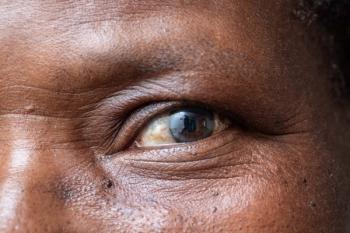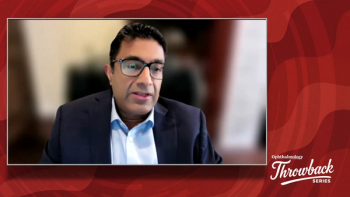
New laser system simplifies astigmatism correction
An experienced user describes the ease and outcomes of astigmatism correction using a proprietary femtosecond laser system.
Reviewed by Mitchell A. Jackson, MD
Lake Villa, IL-Use of a proprietary femtosecond laser system (LENSAR Laser System, LENSAR) is making astigmatism correction easy, efficient, and more accurate, according to Mitchell A. Jackson, MD.
A software upgrade introduced in 2015 (Streamline) enables wireless transmission of preoperative topography data and an infrared image of the undilated eye to the laser. Intraoperatively, iris registration automatically adjusts for cyclorotation, eliminating the need to mark the cornea.
Visit:
Arcuate incision planning using the nomogram the surgeon programmed into the laser is completed at the touch of a button by selecting the “Surgeon’s Table” tab located on the LENSAR programming screen. The treatment is delivered accurately due to the iris registration, using the system’s software for marking the refractive steep corneal axis and placing precise astigmatic incisions (Intelligent Incisions).
“LENSAR with Streamline brings automation, customization, and precision to planning and execution of astigmatism correction, and it has allowed me to consistently deliver predictable outcomes,” said Dr. Jackson, founder and chief executive officer, JacksonEye, Lake Villa, IL.
Dr. Jackson explained the steps involved in performing astigmatic correction with the LENSAR femtosecond laser and provided tips to surgeons for optimizing success.
Complicated cataract:
Currently, wireless integration with the laser is available only when using the Cassini Corneal Shape Analyzer (i-Optics), but compatibility with the OPD-Scan III (Marco Ophthalmics) is coming soon.
One advantage of the Cassini is that it measures total, posterior, and anterior corneal astigmatism, Dr. Jackson said. Although the LENSAR software currently only uses the anterior surface data for astigmatism planning, a future software upgrade will allow surgeons to choose between the anterior and total corneal astigmatism values.
“That will be a nice option because we know from work by Doug Koch, MD, and colleagues that the amount of posterior corneal astigmatism can influence outcomes of our astigmatic correction procedures,” Dr. Jackson said. “Currently, in cases where I expect the posterior corneal astigmatism is impacting the total astigmatism, I will adjust my current built-in nomogram accordingly.”
Premium cataract surgery:
Regardless of which system surgeons use to obtain their preoperative diagnostics information for astigmatic correction, Dr. Jackson emphasized the importance of optimizing the condition of the ocular surface to assure quality data.
“Garbage in, equals garbage out,” Dr. Jackson said, adding that he likes to look for agreement between measurements obtained with several different devices.
Editorial:
The Cassini also captures an undilated image of the iris that will be used intraoperatively for iris registration, and the software confirms its compatibility in terms of proper focus and absence of any lid obstruction.
“Eliminating the need for corneal ink markings to identify the steep axis is now possible with the iris registration capability of Streamline,” Dr. Jackson said.
Editorial:
The diagnostic information is used to guide built-in nomograms for astigmatic correction. Surgeons will need to choose a reliable nomogram from another source when they are first starting to perform femtosecond laser astigmatic incisions. Widely used options for the LENSAR are those developed by Dr. Jackson, Jonathan Solomon, MD, and Rob Weinstock, MD.
“Once the diagnostics data are imported, all the surgeon has to do is press a button and the laser does the rest. However, there is also the option to change any of the parameters on the fly,” Dr. Jackson said.
Related:
Over time, surgeons can tweak the nomogram using their own data. The software for the LENSAR helps with that task as well because it captures all of the information needed, he added.
“Trust the nomogram you start with for the first 50 eyes, and then when you decide to personalize it, change one variable at a time,” Dr. Jackson advised.
When creating their own nomogram, surgeons also need to calculate their average surgically-induced astigmatism for the right and left eyes. A program developed by Warren Hill, MD, is helpful in that regard (
Recent:
Dr. Jackson also highlighted the value of the LENSAR laser’s Scheimpflug imaging systems that allow for dynamic scanning of the cornea and give real-time pachymetric information at the time of femtosecond astigmatic incision creation.
“Corneal hydration is dynamic, and the cornea may become dessicated during the procedure. Astigmatic incisions are usually made at 90% depth, and if the placement is based on a single preoperative reading, the cuts can go too deep and perforate,” Dr. Jackson said. “With dynamic imaging, there is much less chance of perforation and an increased likelihood they will be made at the true intended depth.”
Once the incisions are made, Dr. Jackson said that he generally leaves them closed and has patients return after three to four weeks for evaluation of their refractive outcome. Then, with the patient sitting in an exam lane at the slit-lamp, he can titrate the astigmatic effect as needed by opening the incisions.
“It is easy to do with a Sinskey hook or similar microsurgical instrument,” he said.
As an exception, the astigmatic incisions are opened intraoperatively in cases where intraoperative aberrometry is used (ORA, Alcon) and can determine if additional deepening and/or lengthening of the astigmatic incisions are needed.
Related:
Using the LENSAR laser, Dr. Jackson said that many surgeons treat up to 1.5 D of corneal astigmatism. He, however, is stretching his upper limit to 1.7 D with these techniques.
With the added range and increased predictability compared with manual incisions, Dr. Jackson said he is now using the laser to correct astigmatism in more eyes where he otherwise would have implanted a toric IOL.
“This shift reduces overhead and so helps enhance my bottom line,” Dr. Jackson said.
More:
Mitchell A. Jackson, MD
Dr. Jackson is a consultant for LENSAR, i-Optics, and Marco Ophthalmics.
Newsletter
Don’t miss out—get Ophthalmology Times updates on the latest clinical advancements and expert interviews, straight to your inbox.



















































.png)


